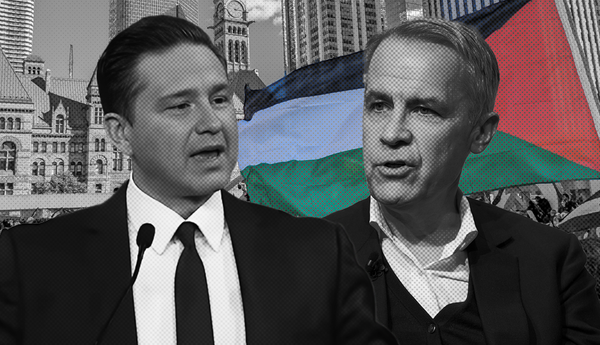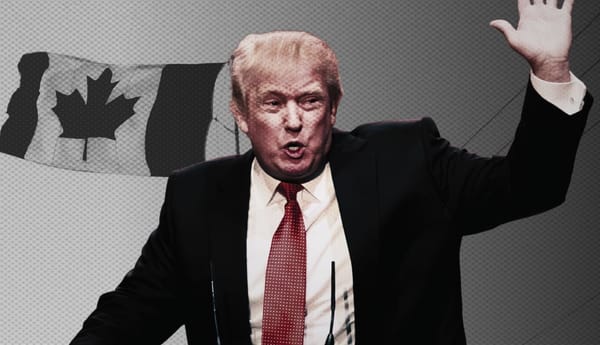On July 8, Rogers experienced an unprecedented network outage that left their customers without access to telecommunications services for most of the day, and in some cases even longer. But it also hit every single Canadian by taking out the Interac debit network across the country, some emergency numbers and other services that people depend on.
After years of anger over high telecom prices and bad connectivity in parts of the country, the outage put telecom back on Canadians radars — but it also helped force experts to reconsider whether the solutions they’d been championing for the past decade will actually solve the problem.
For years, I’ve been arguing that network infrastructure is a natural monopoly and that we should be considering public ownership of telecom companies, but the dominant narrative was that we lacked competition and needed to turn to the market to solve our telecom problems. After a decade of that assertion, Canadians have seen little real benefit.
The Rogers outage has made it clear how there’s a big difference between infrastructure and service delivery, and that there will never be effective competition on infrastructure. That means we need the government to end the competition fallacy and use the tools at its disposal to ensure our telecom networks serve the public, not the shareholders of Rogers, Bell, and Telus.
For this edition of Tech Won’t Save Canada, I spoke to Concordia University professor Fenwick McKelvey about the telecom industry, how it’s evolved over the course of the past century and how we ensure it’s treated as an essential service instead of a capitalist enterprise. It’s a real corrective to the assertion that all we need is more competition.
Below you’ll find an edited transcript of our conversation, but you can listen to the full thing on my podcast.

Paris Marx: Can you explain what the telecom industry is like in Canada right now, including who the major players are and why they hold such a dominant position in the market?
Fenwick McKelvey: Canada has had many different phases of telecommunication policy. It really started out as a bit of a free for all with many different competing networks, and that gradually consolidated into an era of natural monopolies or a concentration in a few state-owned companies. These were spread across Canada and part of a national network called the Stentor Alliance, which allowed for long distance communications.
Beginning in the ’70s, with a turn towards what we now refer to as regulatory liberalism and neoliberalism, there’s a privatization of these companies. The Canadian telecommunication system is still going through that process of privatization where we’ve seen, beginning in the ’80s, these public utilities being sold off and then gradually reacquired into a few large national monopolies.
In Canada, these are fairly protected companies, so there’s conditions around their ownership. The split is usually between two players per province, often the large telephone legacy companies and the large cable legacy companies. In Montreal, we have Bell, which is the telephone company, competing with Videotron, which is our cable company, and there’s some smaller players. In Ontario, where the big Rogers outage took place, you have a real divide between Bell and Rogers.
I want to emphasize the legacy and history of these networks, and part of these histories being caught up in Canada as a settler colonial state. The possibility of these networks to be built isn’t something that’s accidental or easy to do. For Bell’s relationship, it goes back to the railroad, and this is a railroad that, in my learning and knowing, was built largely as John A. Macdonald knew of the starvation that was taking place among the people of the plains and used that as leverage to expropriate territory, in part to build the railroad. Those same rights of way that the railway run on are now being used for fibre backbone.
When we talk about telecommunications infrastructure, we’re not talking about stuff that springs up overnight. This stuff has history and it has dependencies and legacies, and when we’re talking about telecommunications in Canada, we’re talking about the settler colonial project of Canada, which systematically dispossessed certain people from their land, and also from being connected. A lot of the digital divides that exist are in part because of where the railroad didn’t go.
PM: That’s such an essential point, and I’m so happy that you made it. I want to move to the Rogers outage on July 8. The Rogers network went down for virtually the whole day, and that had huge impacts across Canadian society. What was the effect of that outage? And what did it reveal about the industry?
FM: What Rogers says is that three distribution routers in its core network failed or started to misbehave, a filter was removed that propagated the wrong addresses to its core network, and it crashed. That core network was essential for many, many different services. What went down was Rogers wireless, Rogers home internet, Rogers home phone system, Rogers banking systems, in part, its radio stations, parts of its omnichannel distribution systems, its provisions of services it provides to the government, and the Interac banking system that we use every day to make payments. This also affected certain 911 services, as well as critical infrastructure providers.
Here you are talking about this entirety of different companies that are being affected, so one critical question is how is it that Rogers network was designed and built such that everything, including both critical infrastructure and everyday home services, could all be unilaterally affected by this one crash? That raises interesting questions about their network design, what decisions are being made, and corporate governance.
As someone who studied telecommunications for a long time, this outage, this crisis, has really caused reactions. I was in line the other day, and people were joking about maybe having to use a credit card. It’s remarkable how this has turned an issue that’s been long standing for those studying telecommunications into something that everybody now can relate to.
PM: Since at least the days that Stephen Harper’s Conservative government tried to bring Verizon to Canada, the focus of telecom policy has been on competition and the lack thereof in the Canadian market. Do you think that the Rogers outage will finally reset that policy debate, and allow us to look more at regulatory issues rather than simply whether there’s enough competition?
FM: This is precisely the contradiction that belies a lot of interest in telecommunications, and more broadly platform governance, where these companies are profitable and seem to be profitable because of the natural monopoly and the buy-in and lock-in powers that they have.
And yet, at the same time, there’s this perception that the solution is to allow for competition, which is going to bring about something that’s entirely contradictory to why these companies are profitable in the first place. They do have network effects and the idea that you’re going to create competing networks that are going to be able to create or foster this competition hasn’t proven true. In many ways, you could describe the past 20 or 30 years of Canadian telecom policy as a decades-long effort to maintain the fallacy of market competition in the telecommunications sector.
What’s important to remember is that Canada is different. Canada still has common carriage rules, which treat telecommunications companies as critical infrastructure subject to greater regulation. We can talk about whether that regulation is effective or not, but this principle that these companies have a certain power that needs to be taken seriously is an important part of the regulatory tradition in Canada. I would hope this points to an opportunity for renewal.
One of the parts that has been surprising for me is the conversation widening immediately after the Rogers outage. Seeing what has been a fairly narrow conversation of thinking only about competition and the idea that you’re going to have a fourth carrier come in that’s going to fix these problems, and widening it out to have a conversation about a public utility or better public access to these networks is something that’s frankly exciting.
I’ve been frustrated by how the scope of our policy conversations has narrowed and narrowed, particularly focused on this kind of one point of competition as a cure all. Verizon never came, and I think the evidence suggests that Verizon never would have come because it was too costly. It wasn’t something to do with regulatory impediments. It was the fact that if you looked at the market and the cost to get into it, it just wasn’t worth the time and the investment to become a carrier. That’s an important lesson to this possibility of competition.
The long history of public utilities and community-owned networking suggests that there’s different ways of approaching this. There’s a spectrum of options that could be out there from what you were talking about [mobile virtual network operators] or more service-based competition, where you have a public wholesaler and service-based competitors, to something more like public access networks or community access networks. That’s something to acknowledge that we do have in Canada, but it’s one I don’t think we emphasize enough and certainly emphasize a potential solution. And that’s a hopeful change.
PM: In the days after the Rogers outage, industry minister François-Philippe Champagne met with the telecom executives and gave them 60 days to make an agreement on emergency roaming, mutual assistance during outages and a better emergency communications plan. The telecom regulator, the CRTC, also said it was going to investigate and would have recommendations of its own. What do you make of the government’s response to the outage? And do you think it goes far enough?
FM: What’s happened over the Liberal mandate is a real deference to these larger telecommunications companies. A lot of our response to the pandemic and how we rolled out bridging this digital divide has been through incentivizing and funding these companies to build or improve their networks through the new broadband access program. In that sense, I’m slightly pessimistic. The outage emphasizes that the paradigm of “we’re going to have competitors and they’re going to have different networks and it’s going to create resilience in the network” didn’t work; it didn’t happen.
Frankly, it’s as much a government thing as the companies, and the companies are ultimately accountable to their shareholders. The lack of political will when you’re talking about how we’re treating these companies, like being pulled to testify before Parliament, are a largely symbolic gesture. Rogers could file most of its description of what happens in confidence, and we’ll see how effective the CRTC is at demanding accountability on this.
There’s as much pressure on Rogers as there is on government actually showcasing they can have a meaningful interaction. If we’re looking for solutions, we see that there’s more of a fit between a market-based approach to telecommunications and the companies providing them, and so there’s a kind of symmetry between government and these companies, which will lead to what we’ve had for decades: ineffectiveness and a continued fantasy about the possibility of competition.
PM: You talked about how, through the ’80s and even into the ’90s, there was this process of deregulation of telecommunications in Canada to take down some of the restrictions that existed around mergers, acquisitions, other aspects of the telecom industry, as well as the privatization of public players that existed and their eventual integration into this telecom oligopoly. Do you think that the deregulation of telecoms was a mistake?
FM: It hasn’t proven what it claimed to do, which is foster competition and see a competitive marketplace. From more of a cultural vantage point, it’s been interesting just how every subsequent new communication technology has been increasingly private, individually private, in the sense of everybody has their own phone and their own plan, and everybody has their own home internet account.
There’s always been the possibility of the community networks. Canada had the community access program where the internet was in libraries and schools, and there was a more fulsome discussion of what being connected meant and how the information superhighway — let’s use a throwback term — would roll out. When we talk about our public communication infrastructure, the fate of that is decided by a few companies, domestic and international. That winnows our imagination for these critical infrastructures.
We’re at an inflection point where our mobile phones are equivalent to the telephone, and the telephone was treated as universal service. Frankly, right now, should you be paying tax on your mobile phone? Because it’s an essential service? What are the ways of increasing affordability immediately?
There’s been this shift that’s obvious after the experience of the pandemic where we all depend on the internet. It’s critical infrastructure. And yet, the way of imagining what this infrastructure is going to be is largely Rogers’ new Super Ignite internet connection? That, to me, is ultimately one of the ways we really see the possibility of innovation, particularly innovation in connectivity, being defined in narrow terms.
PM: Telephone and television and even cable emerged in these moments where there was a greater recognition that the government had a role to play in ensuring that telecommunication services served a public purpose. But the internet emerges in this neoliberal moment where the government needs to have a hands-off approach and let private companies define what the internet is going to be. Do you think that that shapes how we think about the internet and the role of telecommunications in society today in a negative way?
FM: This is something I say with some reluctance to my past naïveté, but it’s important to emphasize this link between the design of the internet and a neoliberal approach. The success of Silicon Valley was largely through decades prior subsidization of this work, and America’s own hegemonic influence in shaping what became the international networking protocols.
It’s important then to emphasize that part of the way the internet evolved was fairly closely connected with this idea of creating markets and marketization, and I think that’s quite baked into core internet technologies.
In Canada, because the legacy of these infrastructures is not perfect, it’s not idealized competition. There’s this gap where we’re going to have competition and we’re going to have this open innovation, and then there’s just the structural nature of telecommunications companies. Many of the ideas of how the internet works and the idea of internet competition really are out of step with the way that networks are built and rolled out, and the way that in many smaller rural remote communities there’s no incentive to build up multiple networks.
An ultimate question for me is, as a final outcome, was this network failure — the fact that all core activities were running through the same infrastructure — the result of network efficiency, or was that actually good network design? That could be a very direct answer to how, as a result of neoliberalism, the network was being designed in such a way that resiliency and 100 per cent uptime were maybe a secondary concern to the fact that you could lower the network operation costs and try to automate workers that are running them — and shout out to them for getting the network back on so quickly.
PM: During the pandemic, it became undeniably clear that telecom services are essential, as if we didn’t know that before, and there are too many barriers to access from poor connections to high prices — some of the highest in the world for telecom services. Instead of greater competition, is it time to learn from the historical approach and treat it as a public utility, with the proper regulation in place, or even making the telecom companies (or at least their infrastructure) part of a Crown Corporation like we still have in Saskatchewan with SaskTel?
FM: It really pushes towards that being on the table. We do have community-owned networks and community approaches to internet in Canada already. I learned a lot about this from Cree communities in northern Ontario. K-Net was important for me to think about how the Internet could be built, and that was something that was largely community-owned, delivered in part through the collaborations with Bell, but you’re talking about a network that was meeting community needs and accountable to the council.
As much as we want to talk about a big national thing, in some of these communities, is it opportunities for more municipal wireless or more community or provincial options that could be on the table? There’s a whole stack — for lack of a better word — of places where we could start thinking about publicly owned, community-owned innovation, in what we call the internet. That’s something which we haven’t advanced very far, and often my worry is the organizations that we do have, particularly the CBC, aren’t that imaginative themselves to really allow for this.
The thing I’d stress is it’s not building another mesh network, which is something that I was totally suckered on for years, but it’s really about pushing for state or community action. You’re talking about infrastructure that requires institutions to create, and it’s like, how do you either leverage or lobby the existing institutions we have now to work better in the public interest, or trying to think more strategically about what it means to create the kind of organizations that would allow these networks to exist?
We’re not even getting into the internet itself: social media, in many ways, built on and leveraged these ideas and myths of public media, particularly ZeD TV, which Canada’s CBC was really behind, about thinking about being something of YouTube before YouTube. So when we talk about public utilities or public alternatives, the problem runs the whole spectrum, from the core of the internet to the services we use every day.
PM: On your point about community networks and public solutions, it’s always felt weird to me that when we talk about telecom, there’s this discussion that we should have all these options. But in my province, and across Canada, we have a history of public power delivery, where when you move into somewhere new, you don’t need to think about where it’s coming from or the different options that are available for power. Why shouldn’t telecom be that way? If it’s an essential service as well, why shouldn’t we just have a public provider that gives us our telecom services, instead of having all these supposed options that are still reliant on the same networks anyway?
FM: The pressure to sell a product, to sell a new high speed internet product, creates real inequities. One of the things I talk about in Internet Daemons is that there’s a classism that gets built into this between those who can afford high speed and those that are stuck with slow internet. If you’re thinking about your home internet — what your plan is, how much you’re paying for, what your access is — in many ways, the internet would be simpler were there one or two speeds and less complexity about what’s in those plans.
This very idea of internet speed is so closely tied up with the need to create privilege and luxury which you can sell, largely through creating those who are on the budget internet. That’s really something that is at the core of, but hard to explain about the consequences of how we’ve treated the internet and why when we talk about a public utility, there’s a lot being discussed there.
Part of that change is not just management, but it’s also cultural change and what we think about when we talk about coordinated infrastructure, because at the end of the day, no one’s complaining about how fast their internet is, they just want it to work.
PM: It’s fascinating to hear you describe the internet speeds that way. Thinking back to when I did work in telecom, very few people knew what the different speeds meant; they just wanted to know it was going to work well for them and they’d be able to do what they wanted to do.
Aside from the outage, Rogers is in the process of buying Shaw, which is the fourth largest telecom company. The Competition Bureau already seems to have concerns about the merger, not to mention industry observers and the general public. Do you think the outage kills the merger once and for all?
FM: It’s going to make it nigh impossible to go through. There’s been all kinds of terrible mergers, like the Torstar merger where they shuttered all the newspapers. We’ve had a very lax environment when talking critically about mergers, and the evidence is so strong, it’s hard to imagine this happening.
There are real governance questions at Rogers, too. This is a CEO that ousted members of the board. Members of the Rogers family were seen at Mar-a-Lago with pictures of the Trump family. After the ouster, his wife sent a Cameo video with Brian Cox from Succession. There are all kinds of bad public optics in here on top of clear evidence this is not in the interest of consumers.
When we’re talking about affordability or you’re really pushing for coordination issues, you’re seeing not only a shift of why this is a bad idea, but having evidence to point to it being a bad idea. It’s important to remember the stakes are high, but also low in some ways, because there’s so much more to be done. The merger being stopped is a first step to better telecommunications policy in Canada, and better broadcasting policy too.
PM: I’ve really enjoyed this conversation. It’s been insightful, but also kind of mind-expanding in terms of the possibilities for telecommunications as not just a debate about how much competition we want, but what role the government should play in addressing these problems and how we can make the telecommunications services that we all rely on better serve the public.
To close, are there particular regulations or developments that you’d like to see in the telecom sector that we haven’t discussed in this conversation yet?
FM: One of the things I’ve been intervening in in my recent work with my colleague and friend Reza Rajabiun is Bell Canada using an AI system to block fraudulent calls. A move towards artificial intelligence raises critical questions about democratic oversight of telecommunication systems, and whether we actually can know enough about how they work to have proper accountability. That’s something I would like to see, and a way of talking about cybersecurity and security issues in a way that could reckon with this tendency towards privacy and confidentiality, which really run against public participation and the function of an institution like the CRTC.
The future of the internet is often described as zero-touch networking, or lights-out operating centres, or AI chatbots for your assistants. For folks who are looking for these wider issues with artificial intelligence, there’s a key point of where that automation is taking place in networks and whether it’s coming at the expense of the workers.
The networking engineers and the gurus and all the Unix heads that kept these networks running, their jobs are becoming more precarious, and that really raises some questions. That’s to me, one of the outcomes I’d love to see or know about. Was this a network outage that was because there wasn’t enough technicians or the technicians were overworked? What were the working conditions of the people running the network and were they properly supported?
This interview has been edited by Paris Marx for clarity and length.







